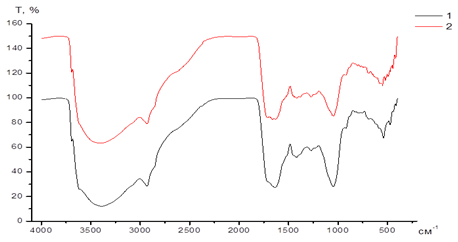HUMIC SUBSTANCES OF PEAT. PROPERTIES AND BIOLOGICAL ACTIVITY
UDC 631.878:631.417
Abstract
Humic substances (HS) are a specific group of high-molecular biopolymers that are formed during the decomposition of plant and animal tissue. It has been established that humic substances have a wide range of biological properties, in addition, humic substances are quickly included in the processes of plant metabolism, which accelerates the development of the root system, increases resistance to adverse environmental factors. But to date, the nature of this phenomenon has not been studied enough. To deepen our understanding of the biological and growth-stimulating activity of humic substances, the influence of prepared solutions with different concentrations of humic substances on seed germination is considered. It has been shown that solutions of humic substances have a beneficial effect on seeds even in small concentrations.
This research work is devoted to the study of the main functional groups of humic substances, such as carboxylic, phenolic, quinoid. Various physico-chemical methods were used in the work to determine the functional and elemental composition of peat HS.
It has been established that peat HS have a stimulating effect and high physiological activity on the growth and biometric indicators of plants, which in the future can determine the increase in yield and quality of agricultural plants.
Downloads
Metrics
References
Orlov D.S., Sadovnikova L.K., Sukhanova N.I. Khimiya pochv: uchebnik. [Soil chemistry: textbook]. Moscow, 2005, 558 p. (in Russ.).
Perminova I.V., Hatfield K. Use of humic substances to remediate polluted environments: from theory to practice. Springer Netherlands, 2005, pp. 3–36. DOI: 10.1007/1-4020-3252-8_1.
Orlov D.S. Guminovyye veshchestva v biosfere. [Humic substances in the biosphere]. Moscow, 1993, pp. 16–27. (in Russ.).
Soromotina T.V. Praktikum po ovoshchevodstvu. [Workshop on vegetable growing]. Perm', 2016, 305 p. (in Russ.).
Fedotov G.N., Shuba S.A., Fedotova M.F., Stepanov A.L., Streletskiy R.A. Pochvovedeniye, 2017, no. 5, pp. 592–602. (in Russ.).
Nardi S., Pizzeghello D., Muscolo A., Vianello A. Soil Biology and Biochemistry, 2002, vol. 34, no. 11, pp. 1527–1536. DOI: 10.1016/S0038-0717(02)00174-8.
Bezuglova O.S. Guminovyye veshchestva v biosfere: ucheb. posobiye. [Humic substances in the biosphere: textbook. allowance]. Rostov-on-Don, 2009, 120 p. (in Russ.).
Balabanova N.F., Voronkova N.A., Volkova V.A., Tsyganova N.A. Agro-Nauka-2020. Tretyaya mezhdunarodnaya nauchnaya onlayn-konferentsiya. [Agro-Science-2020. Third international scientific online conference]. 2020, pp. 16–19. DOI: 10.20913/AGRO-2020-3. (in Russ.).
Voronina L.N., Yakimenko O.S., Terekhova V.A. Agrokhimiya, 2012, no. 6, pp. 42–52. (in Russ.).
Shatokhin K.A. Nauchnyy zhurnal molodykh uchenykh, 2021, no. 3(24), pp. 9–14. (in Russ.).
Yakimenko O.S., Terekhova V.A. Pochvovedeniye, 2011, no. 11, pp. 1334–1343. (in Russ.).
Sherry L. et al. BMC Oral Health, 2013, vol. 13, p. 47.
Savchenko I.A. i dr. Sovremennyye problemy nauki i obrazovaniya, 2013, no. 3. URL: www.science-education.ru/10-9305. (in Russ.).
Stom D.I. i dr. Sibirskiy meditsinskiy zhurnal, 2008, no. 6, pp. 76–79. (in Russ.).
Altieri F. et al. Antioxid Redox Signal, 2008, vol. 10 (5), pр. 891–937.
Zykova M.V., Logvinova L.A., Krivoshchenkov S.V. i dr. Khimiya rastitel'nogo syr'ya, 2018, no. 3, pp. 239–250. DOI: 10.14258/jcprm.2018033925. (in Russ.).
Volikov A.B., Mareev N.V., Konstantinov A.I et al. Agronomy, 2021, vol. 11, p. 2047. DOI: 10.3390/agronomy11102047.
Nebbioso A., Piccolo A. Biomacromolecules, 2011, vol. 12, pp. 1187–1199. DOI: 10.1021/bm101488e.
Popov A.I. Guminovyye veshchestva: svoystva, stroyeniye, obrazovaniye. [Humic substances: properties, structure, formation]. St. Petersburg, 2004. (in Russ.).
Chimitdorzhiyeva G.D., Chimitdorzhiyeva E.O., Tsybenov Yu.B. Uspekhi sovremennogo yestestvoznaniya, 2020, no. 10, pp. 50–54. DOI: 10.17513/use.37490. (in Russ.).
Smit A. Prikladnaya IK-spektroskopiya. Osnovy, tekhnika, analiticheskoye primeneniye. [Applied IR spectroscopy. Fundamentals, technique, analytical application]. Moscow, 1982, 365 p. (in Russ.).
Metody kolichestvennogo organicheskogo elementnogo mikroanaliza [Methods of quantitative organic elemental mi-croanalysis], ed. N.E. Gel'man. Moscow, 1987, 252 p. (in Russ.).
Guben V. Metody organicheskoy khimii. Metody analiza. [Methods of organic chemistry. Analysis methods]. Mos-cow, 1967, vol. 2, 329 p. (in Russ.).
Zakis G.F. Funktsional'nyy analiz ligninov i ikh proizvodnykh. [Functional analysis of lignins and their derivatives]. Riga, 1987, 230 p. (in Russ.).
Orlov D.S. Khimiya pochv. [Soil chemistry]. Moscow, 2005, 259 p. (in Russ.).
Glebko L.I., Maksimov O.B. Novyye metody issledovaniya guminovykh kislot. [New methods for the study of humic acids]. Vladivostok, 1972, pp. 8–32. (in Russ.).
Lovley D.R. Acta Hydrochim. Hydrobiol., 1998, vol. 26, pр. 152–157.
Brovarova O.V. Polucheniye i issledovaniye svoystv sorbtsionnykh materialov na osnove rastitel'nykh biopo-limerov: dis. ... kand. khim. nauk. [Obtaining and studying the properties of sorption materials based on plant biopolymers: dis. ... cand. chem. Sciences]. Syktyvkar, 2006, 156 p. (in Russ.).
Rogova T.V., Syundyukova K.V., Perelomov L.V. i dr. Izvestiya Tul'skogo gosudarstvennogo universiteta. Yestestvennyye nauki, 2013, no. 2-1, pp. 243–280. (in Russ.).
Komarov A.A. Agrokhimicheskiy vestnik, 2009, no. 6, pp. 28–29. (in Russ.).

Copyright (c) 2023 chemistry of plant raw material

This work is licensed under a Creative Commons Attribution 4.0 International License.

This work is licensed under a Creative Commons Attribution 4.0 International License.
The authors, which are published in this journal, agree to the following conditions:
1. Authors retain the copyright to the work and transfer to the journal the right of the first publication along with the work, at the same time licensing it under the terms of the Creative Commons Attribution License, which allows others to distribute this work with the obligatory indication of the authorship of this work and a link to the original publication in this journal .
2. The authors retain the right to enter into separate, additional contractual agreements for the non-exclusive distribution of the version of the work published by this journal (for example, to place it in the university depository or to publish it in a book), with reference to the original publication in this journal.
3. Authors are allowed to post their work on the Internet (for example, in a university repository or on their personal website) before and during the review process of this journal, as this may lead to a productive discussion, as well as more links to this published work.











